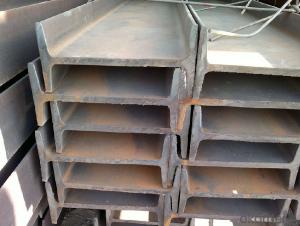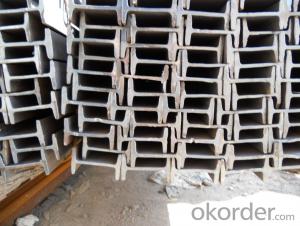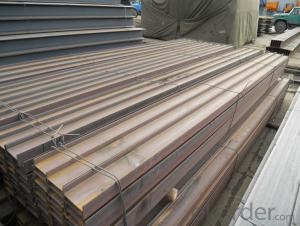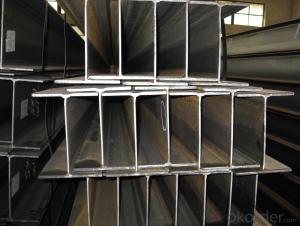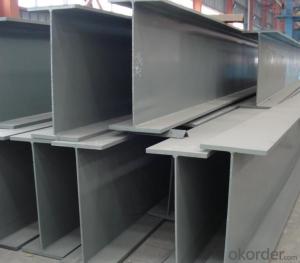European Standard IPE200 Steel High Quality
- Loading Port:
- China main port
- Payment Terms:
- TT OR LC
- Min Order Qty:
- 50 m.t.
- Supply Capability:
- 10000 m.t./month
OKorder Service Pledge
OKorder Financial Service
You Might Also Like
Item specifice
European Standard IPE200 with High Quality
Product Description:
Specifications
1.Standard: EN10025
2.Material: S235JR or Equivalent
3.Length: 6m, 12m
4.Size:
Size (mm) | Mass (kg/m) |
200*100*5.6 | 22.4 |
Usage & Applications
Commercial building structure;
Pre-engineered buildings;
Machinery support structures;
Prefabricated structure;
Medium scale bridges.
Packaging & Delivery
1. Transportation: the goods are delivered by truck from mill to loading port, the maximum quantity can be loaded is around 40MTs by each truck. If the order quantity cannot reach the full truck loaded, the transportation cost per ton will be little higher than full load.
2. With bundles and load in 20 feet/40 feet container, or by bulk cargo, also we could do as customer's request.
3. Marks:
Color mark: There will be color marking on both end of the bundle for the cargo delivered by bulk vessel. That makes it easily to distinguish at the destination port.
Tag mark: There will be tag mark tied up on the bundles. The information usually including supplier logo and name, product name, made in China, shipping marks and other information request by the customer.
If loading by container the marking is not needed, but we will prepare it as customer's request.

- Q:What are the factors to consider when selecting steel H-beams for a project?
- When selecting steel H-beams for a project, there are several factors to consider. First, it is important to determine the load requirements of the project and ensure that the selected H-beams can withstand the anticipated weight and forces. Additionally, the dimensions and sizes of the H-beams should match the specifications and design requirements of the project. Material quality and durability are also crucial considerations, as the steel H-beams should be able to withstand corrosion, weather conditions, and other potential hazards. Lastly, cost and availability should be taken into account to ensure that the selected beams are within budget and readily accessible for the project.
- Q:Are Steel H-Beams resistant to pests or insects?
- Pests or insects cannot damage steel H-beams as they can with wood. Unlike wood, which is easily infested by termites, beetles, or other insects, steel is an inorganic material that does not attract pests. Steel H-beams are usually constructed using high-strength structural steel, which is impervious to any kind of biological deterioration. As a result, they are not vulnerable to damage or destruction caused by pests or insects. This characteristic makes steel H-beams an excellent and long-lasting option for construction projects, particularly in areas where pest infestation is a worry.
- Q:What are the fire resistance ratings for steel H-beams?
- The fire resistance ratings for steel H-beams depend on various factors such as the dimensions of the beam, the type of fire protection applied, and the specific building codes and regulations in place. Generally, steel H-beams have inherent fire-resistant properties due to their high melting point and structural stability. However, to enhance their fire resistance, additional fireproofing materials such as intumescent coatings or fire-resistant insulations can be applied. These measures can significantly increase the fire resistance ratings of steel H-beams, allowing them to withstand fire exposure for extended periods, typically ranging from 30 minutes to several hours.
- Q:Are steel H-beams fire-resistant?
- Yes, steel H-beams are fire-resistant. Steel is an inherently fire-resistant material due to its high melting point and low flammability. H-beams, being made of steel, can withstand high temperatures and retain their structural integrity during a fire.
- Q:How do steel H-beams contribute to energy efficiency?
- Steel H-beams contribute to energy efficiency in several ways. Firstly, these beams are commonly used in the construction industry for the structural support of buildings and bridges. By providing a sturdy and reliable framework, H-beams help to reduce the need for excessive energy consumption during the construction process. This is because they allow for the efficient distribution of loads, minimizing the amount of materials and resources required for construction. Furthermore, steel H-beams are known for their durability and longevity. Unlike other materials, such as wood or concrete, steel beams do not warp, rot, or deteriorate over time. This means that buildings and structures constructed using H-beams will require less maintenance and repair work, resulting in reduced energy consumption and costs in the long run. Moreover, steel is a highly recyclable material. H-beams can be easily melted down and repurposed, reducing the demand for new steel production. This recycling process requires less energy compared to the production of new steel, which helps to conserve energy resources and reduce greenhouse gas emissions. Additionally, steel H-beams have excellent thermal properties. They have a high thermal conductivity, which allows them to efficiently transfer heat and cold. This characteristic is particularly beneficial in energy-efficient building designs, as it helps to regulate temperature and reduce the need for excessive heating or cooling. By minimizing energy consumption for temperature control, steel H-beams contribute to overall energy efficiency in buildings. In summary, steel H-beams contribute to energy efficiency by reducing material waste during construction, providing long-lasting structural support, promoting recycling and reducing greenhouse gas emissions, and optimizing thermal properties for efficient temperature regulation. These factors make steel H-beams a sustainable and energy-efficient solution for various construction applications.
- Q:Are steel H-beams resistant to rot or decay?
- No, steel H-beams are not resistant to rot or decay. Unlike wood, steel does not rot or decay, as it is not an organic material. Steel beams are made from iron with varying amounts of carbon and other elements, which gives them their strength and durability. However, it is important to note that while steel beams are not prone to rot or decay, they can still corrode over time due to exposure to moisture and other environmental factors. To prevent corrosion, steel beams are often coated with protective layers, such as paint or galvanization, which helps to extend their lifespan and maintain their structural integrity.
- Q:Can steel H-beams be used in high-rise buildings?
- Yes, steel H-beams can be used in high-rise buildings. Steel H-beams are commonly used as structural elements in high-rise construction due to their high strength, durability, and ability to bear heavy loads. They provide excellent support and stability, making them a suitable choice for tall and large-scale structures.
- Q:Can steel H-beams be used in cold storage or refrigeration facilities?
- Yes, steel H-beams can be used in cold storage or refrigeration facilities. Steel H-beams are commonly used in construction due to their strength and durability. In cold storage or refrigeration facilities, where low temperatures are maintained, steel H-beams provide the necessary structural support for the facility. They can withstand the temperature fluctuations and extreme conditions associated with refrigeration, making them suitable for use in these environments. Additionally, steel is a good thermal conductor, which means it can efficiently transfer heat, ensuring that the cold storage or refrigeration facility maintains the desired temperature levels.
- Q:Are steel H-beams susceptible to corrosion?
- Indeed, corrosion can affect steel H-beams. Steel, deriving mainly from iron, has a tendency to oxidize when exposed to moisture and oxygen. This oxidation results in the creation of iron oxide, commonly referred to as rust. Corrosion can manifest on both the surface and interior of the H-beams if moisture becomes trapped inside. Nevertheless, susceptibility to corrosion can be lessened through diverse preventive actions like the application of protective coatings, galvanization, or the employment of stainless steel H-beams. Consistent maintenance and inspections are also crucial in promptly detecting and addressing any indications of corrosion.
- Q:Are there any limitations on the length of steel H-beams?
- The length of steel H-beams is subject to limitations. Typically, manufacturing capabilities and transportation logistics dictate the length of H-beams. When it comes to manufacturing, the size and weight of the H-beam can impact the maximum length that can be produced. Specialized manufacturing equipment and processes may be necessary for larger and longer H-beams, which may not always be readily available. Transportation logistics also contribute to the length limitation. H-beams are typically transported by truck or rail, and there are restrictions on the maximum length that can be transported without obtaining special permits. Local regulations and transportation authorities enforce these restrictions to ensure safe and efficient transportation. Moreover, longer H-beams are more susceptible to bending or warping during handling and installation, which can compromise their structural integrity. Therefore, practical limitations on the length of steel H-beams exist considering these factors. To ensure safety, efficiency, and compliance with regulations, architects, engineers, and manufacturers must carefully assess project requirements and limitations when determining the appropriate length of steel H-beams.
1. Manufacturer Overview |
|
|---|---|
| Location | |
| Year Established | |
| Annual Output Value | |
| Main Markets | |
| Company Certifications | |
2. Manufacturer Certificates |
|
|---|---|
| a) Certification Name | |
| Range | |
| Reference | |
| Validity Period | |
3. Manufacturer Capability |
|
|---|---|
| a)Trade Capacity | |
| Nearest Port | |
| Export Percentage | |
| No.of Employees in Trade Department | |
| Language Spoken: | |
| b)Factory Information | |
| Factory Size: | |
| No. of Production Lines | |
| Contract Manufacturing | |
| Product Price Range | |
Send your message to us
European Standard IPE200 Steel High Quality
- Loading Port:
- China main port
- Payment Terms:
- TT OR LC
- Min Order Qty:
- 50 m.t.
- Supply Capability:
- 10000 m.t./month
OKorder Service Pledge
OKorder Financial Service
Similar products
New products
Hot products
Related keywords
